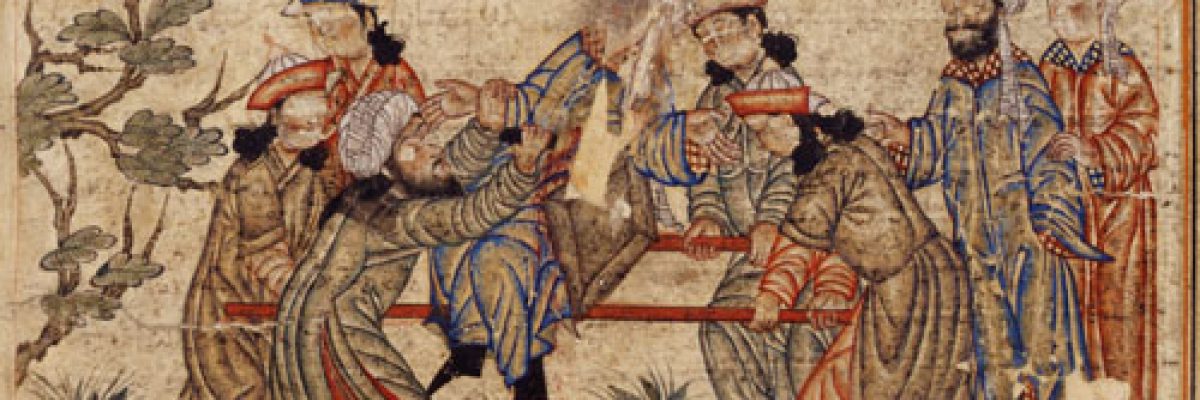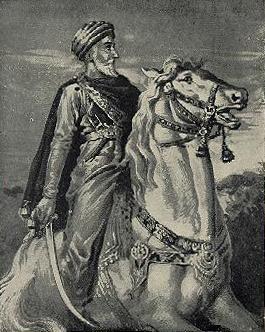One of the groups that used the hash mystic efficiently, which was common in Persia in the past, along with personal terrorism, was established about nine hundred years ago in the mountains of northern Persia. In these places, the Fatimid caliphates were raised – a sect of murderous Shia Islam with no regard for their own lives by themselves or by their leaders – they were a single-use human killing machine. The Nizari Isma’ili sect was established at the end of the 10th century in northern Persia by Hassan i-Sabbah, a poet, theologist, and philosopher. The sect had impressive political achievements, such as territorial and religious sovereignty over multiple areas, while keeping its independence from local powers.
Hezbollah is not a new idea. Its origins are a thousand years old, and they are also Shia Persian. They were called the Assassins, a word derived from Latin languages, and English – meaning suicidal killers with a political agenda. The original idea of the assassins began with Hamdan Ibn al-Ash’at, also known as Qarmat, who was an Isma’ili Shia leader at the beginning of the 10th century in Syria, Israel, and Iraq. Qarmat came from southern Iraq, where he started a society with common property that loyally obeyed one leader. The society was working towards and chasing social justice. The Qarmats established a religious state in the Arabian Peninsula, conquered Mecca in 930 A.D., and held it for 20 years while robbing the black rock in the Kaaba.
The Assassins sect started its activity at the end of the 10th century, in northern Persia, by a poet, theologist, and philosopher, an ideologist with the power of persuasion, organizing capabilities, and a lot of charisma, called Hassan i-Sabbah. The Assassins’ terror state had impressive political achievements due to the use of terror. At their peak, the Assassins got a territorial and religious sovereignty over vast areas between Persia and Lebanon, guarding their independence from local powers and countries that were much stronger. The Suni Islam, who could not deal with the Assassins (the pure-blooded, very similar to the party of God – the Hezbollah), tried to defame them, claiming they sacrifice and commit suicide because of hash. They called them ‘The hash people’. Hassan i-Sabbah raised a sect of single-use human killing machines, who had no care for their own life in their and their leaders’ eyes.
Shia Islam was created a short time after Islam started, as a result of an argument on who is the heir of the prophet Mouhammad. His successors, who started the traditional Suni Islamic stream, claimed that Mouhammad had a substitute – a Caliph, chosen by a group of close associates, while Mouhammad’s family, his daughter Fatima and her husband Ali, claimed the prophecy runs in the family, and that blood ties are stronger than an external appointment. This argument created a rift in Islam, based on the Shias claim that leadership is inheritable and not passed to a chosen person. There is no way to know who the leadership will be passed to, besides a godly mark – the Imam – who is an omnipotent figure who is the only one with a huge impact on the ones led by him.
The Shia reached the peak of their power between the 9th and the 11th centuries, with the founding of the Fatimid dynasty, named after Mouhammad’s daughter. The Fatimid built Cairo (al-Qahira – the victorious) and adorned it with madras (places for Quran studies), institutes for caring for the mentally ill, impressive khans, and the University of Al-Azhar. With the downfall of the Fatimid power. Towards the end of the 11th century (1094), an argument started from the inside. Some of the Fatimid supported a successor called Nizar, but the army, which in fact ruled the country, where the Fatimid leaders were mere puppets, crowned Al-Musta’li. As a result, the Isma’ili split into those who supported Al-Musta’li, and those who did not, who claimed the next Imam was Nizar. The Nizari Isma’ili made Persia the center of resistance. Hassan i-Sabbah, the founder of the Assassins, went to the Fatimid center in Cairo, escaped from there after the dynasty was replaced, wondered for 9 years, and in ways of preaching, personal example, and theological arguments in which he proved to have the upper hand, he expanded his sects’ base, and formed a network of faithful secret believers all around central Asia, Persia, and the near east.
Hassan i-Sabbah was born in 1060 in the Persian city of Qom. He was educated by the poet, mathematician, and astronomer Omar Khayyam and Nizam al-Mulk. The three had separated earlier when Omar Khayyam worked hard on mathematics and secretly wrote the eternal “Rubaiyat”. Nizam al-Mulk became the great Seljuk wazir and exiled Hassan i-Sabbah from the Seljuki land when they clashed about where power should lay. He was murdered in old age, on his way from the king’s yard to his castle, on the command of Hassan i-Sabbah.
After being exiled from the Seljuki land, Hassan i-Sabbah chose to reside in the Alamut Castle in the Alborz mountains in northern Persia. Alamut is at the end of the valley, and the road leading there is through a canyon with a flowing river. Beyond the canyon crevice, the view of the valley opens. The castle’s location, which was the Assassins’ capital, is above the valley. Marco Polo described the Assassins and the castle as “the eagle’s nest”.
Since Hassan i-Sabbah did not have missiles or rockets, he created his intimidation reputation by training the Assassins to be lethal suicide precise human killers, and turned them into a strategic terrifying tool, with which he could deter the Seljuki forces from his territory – which were, on paper, a much stronger, imperialist force than he was. The Persian traveler Nasir Khusraw and the Arabian Geographer Al-Maqdisi described them in this manner: “Hassan i-Sabbah as his own method of education – strict celibacy life, no music playing or drinking. He executed both his sons, one for being accused (false testimony) in killing Da’i – a preacher – and the other one he killed because he drank”. He improved and toughened the sect with secrecy, training in killing techniques, courage tests, and blind obedience to one leader – a spiritual and military leader in one figure – the Imam.
According to sources, a mother blackened her face and cut her hair when her son returned alive from a murder mission where his friends got killed. In the base of the sects’ philosophy stood the ideal man – of Persian origins, Arabic religion, Iraqi culture, Jewish experience, Christian methods, Syrian way of life, Sufi devotion, Greek science, Indian wisdom, angelic behavior, heavenly ideas and knowledge, and selected for eternal life. The murderous politics of the Assassins included many victims from the Seljuki governmental circles – political terror in order to erode and spread terror at the high towers. According to one of the stories the Assassins stabbed the Seljuk sultan Sanjar on the side of his body in his sleep to “hint” that if he did not leave them alone, they would stab him in the heart. They assassinated the Suni Baghdadi governor and then celebrated his violent death for seven days and nights. Murder and assassination as compensation for damaging their lands were a way of life for them.
Benjamin of Tudela (1179 – 1183) met the Assassins twice. Once in Lebanon and Syria and once in Persia. In Persia he even found Jews amongst the Assassins: “and from there four days to the land of deserters, it is a nation that does not believe the religion of Isma’ili, and sit in the high mountains, and they answer the old man in the country of al-Hash, and among them, four communities from Israel, going to war with them, though they do not carry the burden of the king of Persia, since in the high mountains they live, and come down from the mountains to rob and scorn the ones who go up the mountains, and no man can fight them, and the Jews within them are also students of wise men and are under the jurisdiction of the head of the community in Babel”.
The assassination method proved itself and became the primary strategy used by the Assassins, even after Hassan i-Sabbah’s death, and Rashid ad-Din Sinan, the old man from the mountains, inherited it. He was the one who built the Assassins’ state in Syria and Lebanon, and one of its fortresses was for a short while Nimrod Fortress. That is where the crusaders and western people met the assassins and how the word had rolled to Italian and other European languages – assassin.
Rashid ad-Din Sinan was described by his biographer, Kamal el-Dine: “My brother (Allah have mercy on his soul) told me that Sinan sent a messenger to Salah a-Din (Allah have mercy on his soul) and told him to give him the message in private. Sala a-Din commanded to search the messenger, and when nothing dangerous was found on his body, he sent everyone out of the room, leaving only a few of his personal guards, and asked the messenger to give him the message. But the messenger told him: my master commanded me to give you the message only when we are completely alone. Salah a-Din sent all the bodyguards except two and said: give me the message. The messenger replied: I was commanded to give you the message only when we are completely alone. Salah a-Din said: these two never leave my side. If you want – give me the message, if not – be on your way. The messenger asked: why don’t you send these two like you sent the other ones out? Salah a-Din answered: these two are like my children. They and I are one. And then turned the messenger to the two king’s guards and said: if I command you in my master’s name to kill this sultan would you do it? They said yes and pulled out their swords calling: Command us, and we will do as you say! The sultan Salah a-Din (Allah have mercy on his soul) was left speechless. The messenger left, taking the bodyguards with him. After that, Salah a-Din (Allah have mercy on him) decided to make a peace treaty with the old man from the mountains and remain in close friendship. And God knows it all”.
The Assassins’ blind obedience was legendary. By one of the crusaders’ sources, when Henry of Champagne, king of Jerusalem, visited one of the Assassins’ castles in Syria, his host invited him to a stroll on the castle’s walls. To demonstrate the immediate, undisputable loyalty of his subjects, the castle ruler turned to his Padinis – a nickname for those willing to sacrifice their lives on the altar of faith – who were simply standing on one of the adjacent towers, and with a flick of a hand commanded them to jump off the wall. The young ones jumped from the wall right away, crushing to death on the rocks beneath them. The crusaders were in good relations with the Assassins since the Assassins were a Shia Muslim sect in conflict with the Seljuk ruler – The Suni Muslims of Damascus, therefore, they stayed in their mountainous fortresses and made defense alliances with the crusaders. One of the fortresses they used was the Nimrod Fortress standing above the sources of the Banias river. Banias was another Assassins’ city. Following the treaty signed in 1129, The knights of Rainier de Bruce the Norman entered Nimrod Fortress on the edge of the Hermon. That was the sect’s first lethal encounter with the west, now, they were not only killing Seljuki and Abbasid, but they also hurt the crusaders. One of the most significant killings made by the assassins is the killing of Conard of Monfort, who was the king of Jerusalem and the prince of Tyre. Conard was in a conflict with king Richard the I of England and with Salah a-Din, who demolished the kingdom of Jerusalem when ruled by the crusaders a few years prior. His death stopped the planned crusade to reconquer Jerusalem. Political murder in that time and place. His murder was described by Ambreve, a poet that joined Richard the I’s camp:
“Two young men, wearing casual instead of robes, daggers in their hands, sent their hands out to grasp his throat, and in a single flick of a hand threw him to the ground, and each of them sunk his blade in his body. Those bastards, who betrayed him like this were the assassins from the mountains” …
In the east, the Assassins’ fearsome potential got all the way to Mongolia. William of Rubruck, a missionary and explorer who arrived at Karakoram, the capital of the Mongolian Khan, told of the fear of Mongake, the Mongolian Khan, from Assassin infiltrates. No one could be trusted. They could have been wearing Mongolian army uniforms. The rumors say they manage to infiltrate his personal guard.
William of Tyre, who was born in 1130 and was one of the most important historians of his times, an experienced traveler, who spoke Arabic and knew the dwellers of these lands, was asked by Amalric to write the history of the Latin kings of Jerusalem. William’s book is called: “Latin Chronicles” (1182 – 1184): “One can find in the Tyre region, which is also called Phoenicia, and in other sources, Tortosa, a nation which rules ten strong fortresses, with independent villages belonging to them, their numbers, as far as we heard, is 60,000 maybe more. Their tradition is to appoint a leader, which is not passed by heritage but by considering his best qualities. Because they despise titles of honor, they call him the old man. The obedience and loyalty bonds that tie this nation to their leader are so strong, that no task is undoable, impossible, or risky for them, and none of them would refuse to commit a task with fanaticism and complete devotion if their leader commands them. If, for example, there is a prince these people hate or mistrust, the leader gives one or a few of them daggers. They leave as soon as they are commanded, not thinking of the outcomes or ways to escape. They just want to do the did fanatically, strategizing, planning, and waiting all the time needed until the time is right for completing their leader’s command. Even our people (the crusaders) and the Saracens (Suni Muslims) call them Assassini, we do not know the origin of the name”.
In the West, the name of the Assassins was associated with the horror-inflicting culture of the assassination and murders by Dante the Assassin, so it rolled into the Latin and English languages as an adjective for a killer. Arnold from Lubeck was sent to Syria as an agent of the German Caesar Barbosa in 1175. Arnold assumed that a drug was responsible for the Assassin’s fanatic behavior. The Assassins were called the Hashassins, as a part of the anti-Shia propaganda of the Suni, claiming they are lethal because they act under the effect of hash:
“In the mountains close to Damascus, Antioch and Aleppo, lived a group of Saracens (Muslims) called in their native tongue Hashassins, and in Latin Senores de Montaña (masters of the mountain). They live lawless lives, feed on pork as opposed to the Saracen law, and use every woman they can find, including their sisters and mothers. They live in the mountains, and their fortresses are impregnable. Their land is not fertile, so they eat their livestock. Ruling them is one prince who terrorizes all the Saracen princes, the one in kingdoms adjacent to his, and ones further away. He is terrorizing the neighboring Christian princes as well since he kills them regularly in a surprising way. The did is done in this matter: the prince has in his mountain kingdom numerous incredible castles surrounded by a strong, tall wall, so no one can penetrate it unless it is through a small gap, which is heavily guarded. There he raises the farmer’s sons from early youth. These young boys learn many languages: Greek, Latin, Roman, Saracen, and many other languages. These boys are trained by their teachers to obey every word their master commands, and if they would do so precisely, their master, which has more powers than any living god they worked for before, will give them all the pleasures of paradise. They do not see or meet anyone but their teachers and master since childhood until their master commands them to kill.
The day they are brought in front of him, he asks them if they will obey his commands so he can give them to heaven. And then, since they were trained for many years, without a second thought or any resistance, they throw themselves to their master’s feet and answer fanatically that they will obey anything he commands. Then their master gives them golden daggers and sends them to kill the prince or king he chose.
I will tell you things about the old man that might seem stupid and unfounded, but I heard them from a trusted witness under an oath. The old man mislead his compatriots with spells and made them believe that there is no god but him. He also cast a weird spell on them by promising eternal pleasures and making them prefer death over life. Some of them, stationed on the high wall, will jump down as soon as he signs to do so, and crack their skull to the most horrific death. The most blessed ones, he says, spill the blood of others, and then as a reward, they are executed. Therefore, they choose this way to die – kill someone with a plot, and then they are executed. He will give them daggers, which are, as I was told, sacred and anointed with poison, and then he drugs them with a potion. They enter a state of ecstasy and intoxication, and then he shows them with his magic fantastic visions, visions filled with pleasures and happiness – or should we say foolishness – and then he promises these pleasures they saw during the false visions as a reward for their actions”.
The end of the Hashassins came when the Mongolians decided they were not willing to suffer from their threats anymore. The Mongolian Khan went to Alamut with a giant army in 1254. He captured the leader of the Assassins and demanded him to tell his people to surrender. The Assassins’ leader did as he was commanded. When Hulagu finished subjugating and capturing all the Assassins’ castles, he took him to the desert, closed him in a sac, and let his horses step on him until he died. That period was also the rise of Baibars the Malik, who defeated the crusaders and started an empire from Cairo to Damascus. He was also not willing to deal with compromises, threats, and extorsion. A new order. He destroyed the Hashassins castles, one by one, and eliminated the Hashassins Nizar-Isma’ili country.
After the Assassins were defeated by the Maliks on the Syrian- Lebanese front and the Mongolians on the Persian front, they disappeared as a group with a territorial identity and went to different places. Today, Nizar-Isma’ili groups are still found in India, China, Pakistan, and Tajikistan, and their leader is the Aga Khan – the leader of an extremist peace-chasing sect that seems very distant from their bloody, fanatic past.
It is a great example that with determination and firmness, directions could shift, even with violent fanatic groups.








